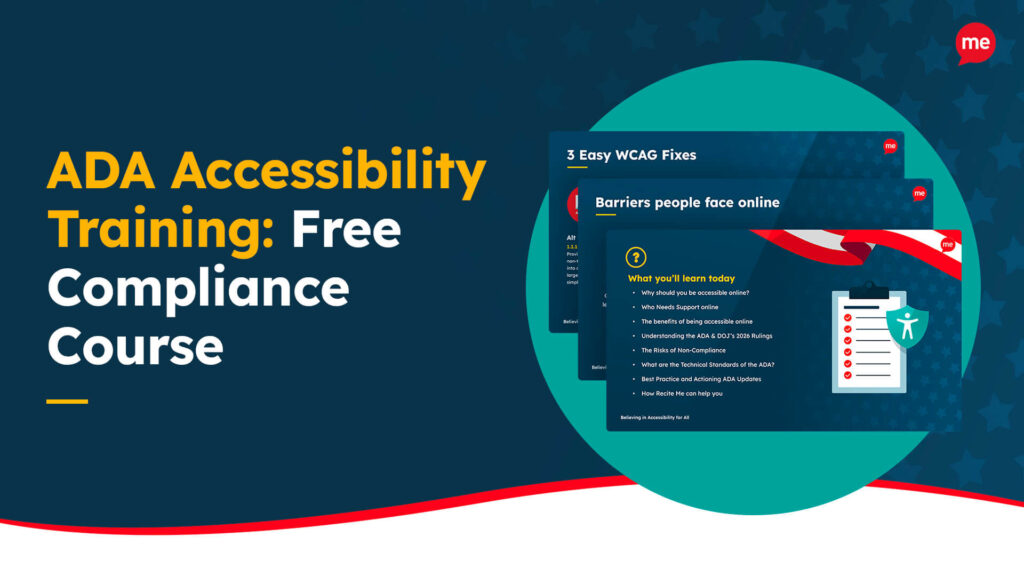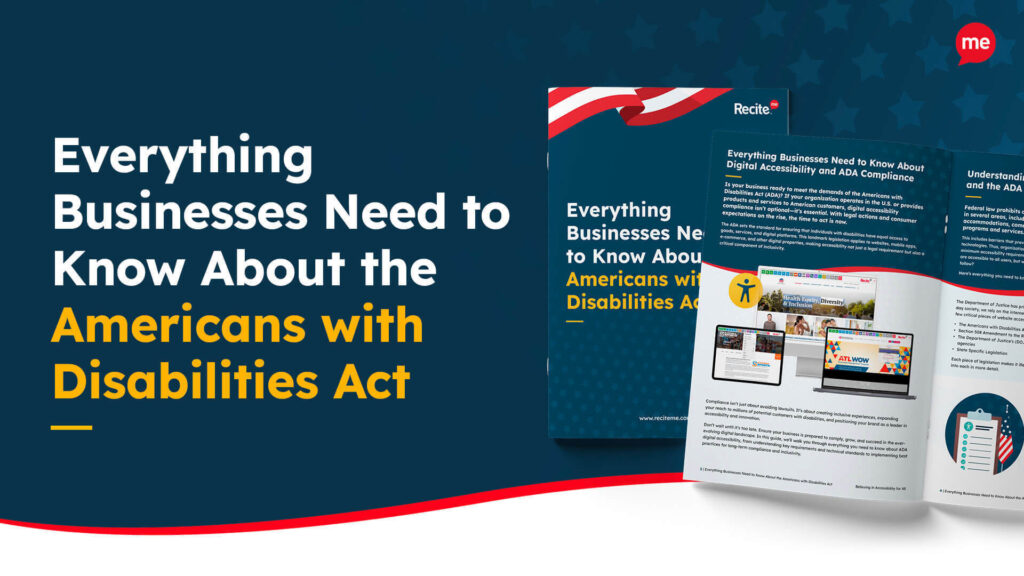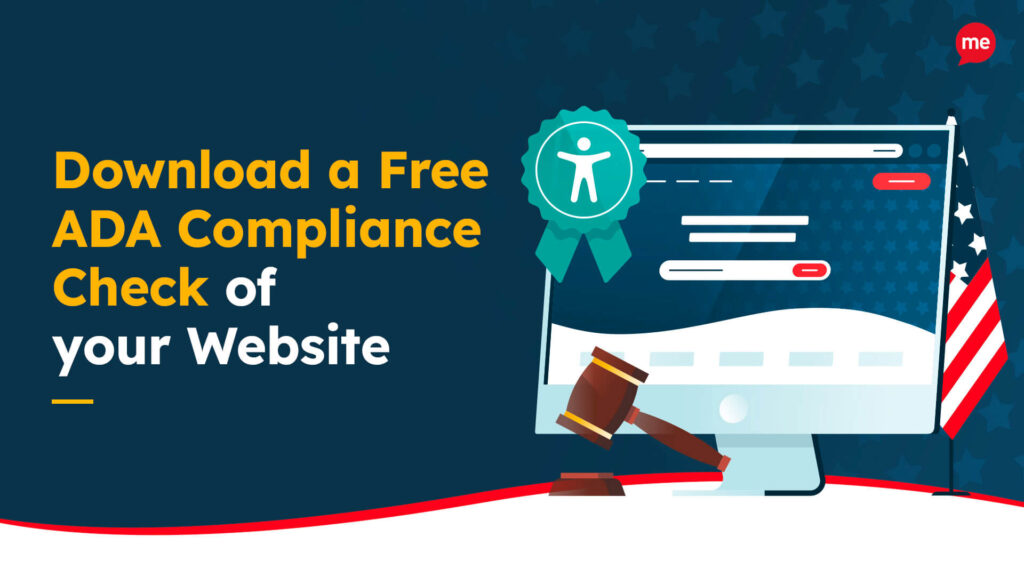Get A Free ADA Compliance Audit Of Your Website
Download NowWithout a proactive approach to ADA compliance, your business could find itself among the thousands facing lawsuits for inaccessible web design. Many business owners in Arizona don’t realize that the Americans with Disabilities Act (ADA) extends to digital spaces, leaving them vulnerable to legal action. Last year alone, more than 4,000 web accessibility lawsuits were filed under the ADA. These lawsuits bring with them a litany of legal challenges, not least financial loss and reputational harm. Navigating this legal minefield can be stressful if you don’t know what to look for. So, to help you avoid becoming another statistic, we’ve laid out the answers to all your questions.
What is the Americans with Disabilities Act (ADA)?
The ADA was signed into law in 1990 with the aim of making illegal any discrimination against individuals with disabilities across all areas of public life. This includes employment, education, transportation, products and services, and now websites. It was designed to ensure that everyone, regardless of ability, has equal access and opportunities — a transformative act that paved the way for other disability rights laws to follow.
To truly understand the ADA’s requirements, we must unpack the contents of the law. The ADA is split into five chapters, known as titles, where each one focuses on accessibility in a specific area of public life. Here’s a brief summary:

- Title I: Employment – Prohibits workplace discrimination against individuals with disabilities. Arizona employers must provide reasonable accommodations, such as accessible workstations.
- Title II: Public Services – Requires state and local governments in Arizona to make programs and services accessible to individuals with disabilities. Think public transportation systems or city hall services.
- Title III: Public Accommodations – Mandates that privately owned businesses in Arizona, such as restaurants, theaters, and hotels, ensure their facilities are accessible to everyone.
- Title IV: Telecommunications – Ensures accessible communication services for individuals with hearing or speech impairments, including relay services.
- Title V: Miscellaneous Provisions – Covers a range of topics, including rules for handling retaliation claims and clarifications about how the ADA applies to other laws.
Title III is of particular interest because, while originally focused on physical spaces, it has since evolved to include digital spaces too. Courts of law now interpret websites and mobile applications, to be public accommodations. This means that compliance extends beyond physical accommodations like ramps and elevators, to include digital accommodations like alt text and screen reader compatibility.
Want to make sure your website is compliant with the Americans with Disabilities Act? Then unlock the ADA compliance checklist now. Discover actionable steps to ensure ADA compliance, helping you avoid lawsuits and any other negative consequences of non-compliance.
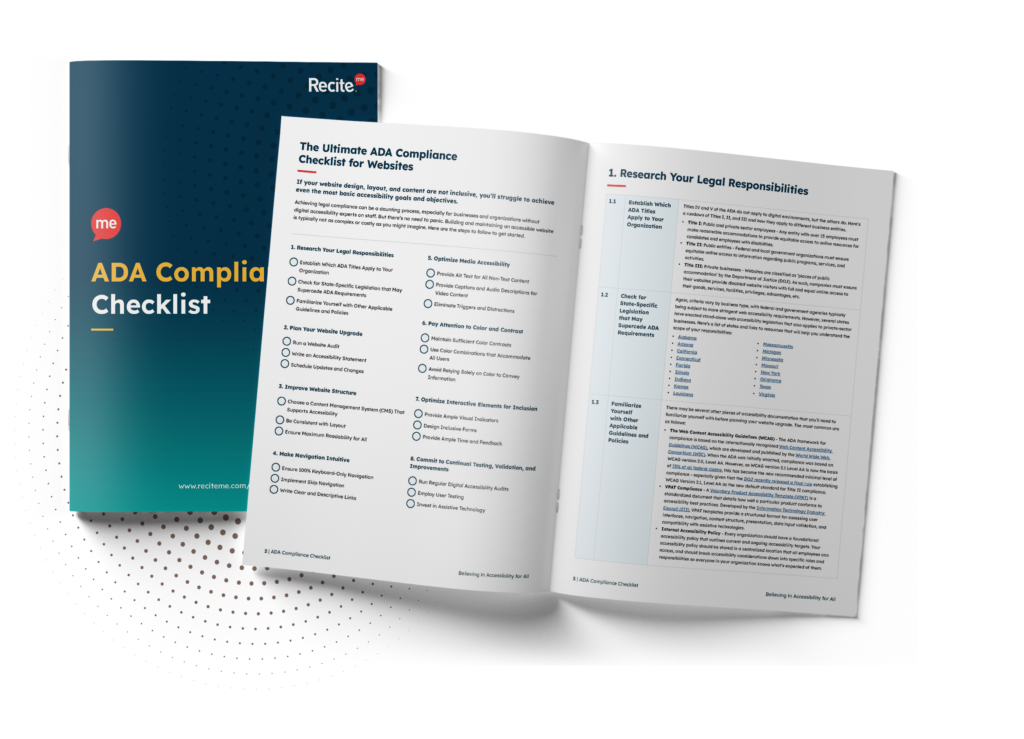
Who needs to comply with ADA guidelines in Arizona?
ADA compliance applies broadly to both public and private entities. In Arizona, here’s who must meet these requirements.
State and local governments
Arizona government agencies, such as city offices and state services, are also required to meet ADA requirements. As such, they must ensure equal access to programs, services, and activities offered by government entities.

Public accommodations
Under Title III of the ADA, any private or public entity that is open to the public must comply with the ADA. Public accommodations include restaurants, retail shops, gyms, and hotels, among other things. However, as mentioned earlier, the definition of public accommodations has recently expanded to include websites. This means that even e-commerce stores, online educational platforms, and government websites are subject to ADA stipulations.
Employers with 15 or more employees
Whether you’re a business to customer or business to business organization, if you have 15 or more employees, the ADA applies to you. This means ousting discriminatory practices from every aspect of employment, including the hiring process, promotions, compensation, job assignments, training, etc. It also means making reasonable accommodations for disabled members of staff.
Tips for ensuring Arizona ADA web compliance
If the ADA applies to your Arizona business, your next step is to make sure your website is accessible. Crucially, web accessibility and ADA compliance are rooted in the Web Content Accessibility Guidelines (WCAG) – the gold standard for designing accessible websites. So, we’ve taken a look at some of the most common WCAG failures and put together a list of actionable tips to get you on the right path.
1. Conduct an accessibility audit
Accessibility audits tell you which areas you need to work on. They flag non-compliant website features and offer guidance on how to fix them, making audits the obvious starting point. Consider using automated auditing tools like an accessibility checker before moving on to manual testing methods for more comprehensive audit results.
Discover how you can use an ADA audit for web compliance here.
2. Improve color contrast
Make sure text is readable against its background by opting for high contrast colors. For example, avoid light gray text on a white background, as this can be challenging for users with visual impairments to distinguish. Following WCAG 2.1 Level AA guidance, ensure a minimum color contrast ratio of 4.5:1 across your web pages for all normal-sized text.
3. Add descriptive alt text
Every image on your site should include alt text that explains what’s being shown. This helps blind or visually impaired users who rely on screen readers to perceive visual content which they would otherwise not be able to.

4. Enable keyboard navigation
Make sure all areas of your website can be accessed using nothing but a keyboard. This includes buttons, links, and menu options. You can test keyboard navigation by using the Tab and Enter functions on your keyboard to navigate through your site.
5. Test your forms
Forms should be easy to engage with. They should have clear instructions, labeled fields, and informative error messages that guide users on how to fix mistakes. What’s more is that users should be able to complete forms without needing a mouse.
6. Use descriptive link text
Avoid using vague link text like “click here”, as this provides little to no context for screen reader users and ultimately leads to confusion. Instead, use descriptive phrases like “Download our Arizona Accessibility Checklist”, so that users know exactly what they are clicking on.
7. Provide video captions
Video content can be difficult or impossible for users with hearing impairments to follow. Captions or transcripts allow these users the same access to videos as everyone else. Just ensure your captions are accurate and synchronized appropriately with the video.

8. Train your teams
Finally, make accessibility a team-wide responsibility. Educate employees about ADA requirements, WCAG standards, and accessibility best practices. This helps integrate inclusivity into standard business practice.
You can download our ADA accessibility training course here for free.
What are the consequences of ADA non-compliance in Arizona
In an ideal world, we wouldn’t need laws to enforce accessible web design. After all, inclusion alone should be motivation enough to make your website accessible. However, with that said, the threat of lawsuits is very real; lawsuits make navigating ADA compliance a legal and financial minefield. Here’s what’s at stake for Arizona businesses.

Financial Penalties
Non-compliance can result in costly ADA lawsuits and settlements, sometimes exceeding tens of thousands of dollars. For first time offenses, penalties can be in the range of $75,000, with this increasing to $150,000 or more for repeat offenses. In Arizona, legal fees of this magnitude have been known to cripple small businesses.
Lost revenue opportunities
By excluding disabled users from your website, you’re also missing out on their business. With approximately 13.4% of Arizonans living with a disability, this is a significant market. Once rejected, consumers tend to take their business elsewhere, often to more inclusive competitors.
Regulatory scrutiny
Repeated non-compliance can lead to increased monitoring and stricter oversight from regulatory bodies, adding to your administrative burden.
Operational setbacks
Legal challenges require time and resources that could otherwise be invested in growing your business. The lawyer costs alone could require investment to be diverted away from crucial ongoing projects. As well, settlement agreements often call for remediating action to take place under strict deadlines, putting business operations on hold until complete.
Reputational damage
In today’s connected world, news of a lawsuit spreads quickly. Arizona consumers, like many other states, value inclusivity, and failing to meet accessibility standards could harm your brand image. Reputational setbacks like this can be hard to come back from.
Get a free automated ADA compliance audit of your website. This audit will highlight compliance violations and provide the recommendations needed to meet ADA compliance standards.
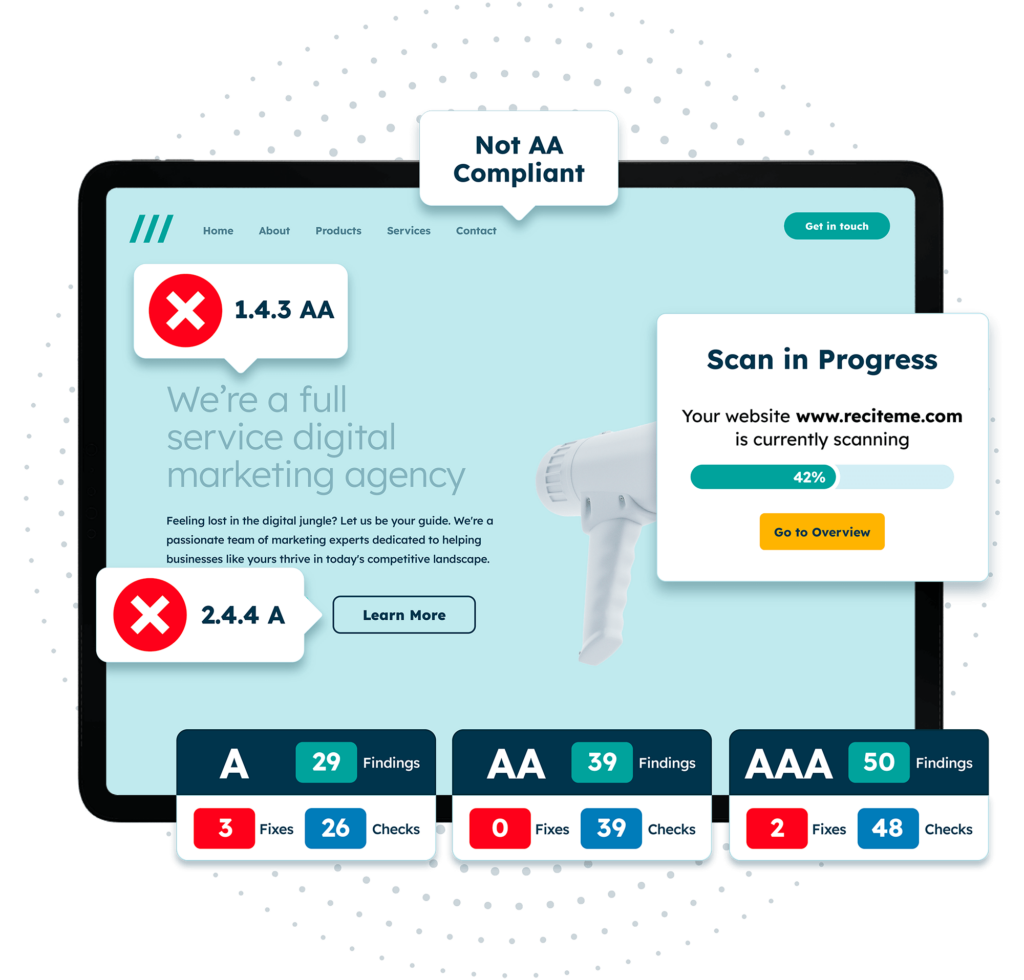
Real Arizona ADA lawsuit examples
It’s one thing reading about ADA non-compliance from afar, but how does this play out in practical terms? In this section, we explore a couple of real ADA lawsuits involving Arizona-based organizations.
James Close v. Four Arizona Websites
In 2017, James Close, a blind individual residing in Texas, filed lawsuits against four Arizona businesses, alleging that their websites were not accessible to visually impaired users.
Close claimed that each of the four websites was in violation of Title III of the ADA. He asserted that the websites were incompatible with screen-reading software and other assistive technologies, preventing him from accessing content, locating store information, and making purchases.

He sought permanent injunctions requiring the businesses to:
- Hire qualified consultants to ensure website compliance with WCAG 2.0 Level AA standards.
- Train employees involved in website development on WCAG 2.0 compliance.
- Conduct ongoing audits and testing to maintain compliance.
- Develop an accessibility policy featuring contact information for reporting accessibility issues.
Close demanded that each of the four websites be shut down until they complied fully with the Arizona ADA requirements. This case highlights the increasing legal focus on web accessibility and speaks to the disruptive nature of lawsuits.
Arizona Department of Child Safety
In December 2024, the U.S. Department of Justice found that Arizona’s Department of Child Safety (DCS) violated the ADA by discriminating against parents and children with disabilities. Allegations included failing to provide necessary communication aids, such as sign language interpreters, and not offering reasonable accommodations for parents with disabilities.

The DOJ recommended that Arizona’s DCS implement policy changes to ensure parents and children with disabilities are not discriminated against in DCS programs and services. The DOJ also recommended that the DCS provide training for its staff on ADA compliance, and take additional steps deemed necessary to remedy the discrimination that took place.
Need more help becoming ADA compliant?
The following resources are packed full of actionable tips and expert advice for making your digital content compliant with the Americans with Disabilities Act:
Free ADA Accessibility Training
Take the first step to ADA compliance by completing our training course.
Free ADA Accessibility Guide
Ensure your organization is meeting the requirements for ADA compliance.

